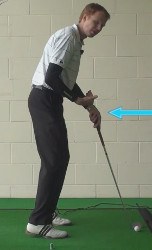
There's a very simple address element that can greatly influence the flight of your shots – the height of your hands. Let's examine the two common positions that fall outside the “neutral” zone:
“High” Hands
This means the hands are farther away from the body, with the arms and club forming a straight (or nearly straight) line from shoulders to ground when viewed looking toward the target. Golfers with high hands typically:
- Have more upright (vertical) swings.
- Hit the ball higher.
- Tend to fade the ball (left-to-right shape for right-handers).
- Are more susceptible to slicing.
“Low” Hands
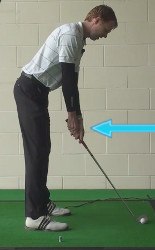
This means the hands are closer to the body – generally hanging toward the knees -- creating more hinge in the wrists and an angle between the arms and shaft. In general, golfers with low hands:
- Have flatter (more horizontal) swings.
- Hit the ball lower.
- Tend to draw the ball (right-to-left shape for right-handers).
- Are more susceptible to hooking.
If you're struggling with your ballstriking, a simple adjustment of the hands could be the answer. For example, if your shots are drifting too high and right, lower than hands just a touch at address. If you've been prone to low hooks, move them up slightly.
You can also alter your hand position when you need a different ball flight for a certain situation. Let's say you've got to get the ball up quickly over trees – stand taller and move a little closer to the ball, which will raise your hands and produce a higher shot. Do the opposite when you've got to pull off a low draw or running hook.
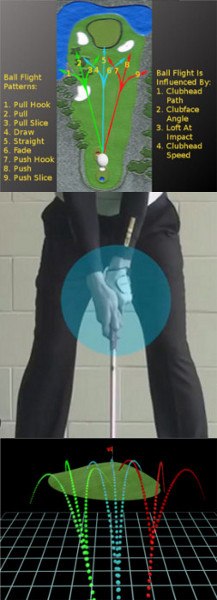
How Hand Placement Affects Ball Flight
To play good golf, you need to have control over your ball flight. One of the best ways to become consistent on the course is to know which direction your shots are going to turn once they get up into the air. Even if you don't hit the ball right at the target on each and every shot, simply knowing if your ball is going to turn to the right or to the left will put you way ahead of the game. Most golfers have one specific ball flight that they try to use more than any other, but it is always a nice advantage to be able to hit a variety of shots based on the layout of the course in front of you.
You don't need to copy the ball flight of another golfer in order to improve your game. In fact, you will be better off if you choose your own ball flight based on the natural tendencies of your swing. There have been plenty of golfers throughout the history of the game that have played well while favoring a draw, and there are just as many good players who have favored a fade. This isn't a case of picking which ball flight is 'better', because neither one is better than the other. As long as you can repeat your chosen ball flight over and over again, it will be able to work nicely for you on the course.
The way you place your hands on the club has a lot to do with the ball flight you are going to be able to achieve. For that reason, you need to make sure that your grip is designed to help you create your desired ball flight. Many golfers make the mistake of trying to hit a fade with a draw grip, or vice versa. You don't want to make the golf swing any harder than it already is by using a grip that goes against the shots that you are hoping to hit. Match up your ball flight plans with your hand placement on the club to make the game just a little bit easier.
Once you settle on the hand placement that you are going to use in your grip, make sure it remains the same shot after shot, all throughout your round. You want to remove as many variables as possible from the golf swing in order to improve your performance, and keeping your grip the same will give you a nice feeling of comfort prior to each shot. Practice your grip as much as possible – even when you are away from the course – so that it becomes second nature to position your hands the same way each time you pick up a club.
The instruction below is based on a right handed golfer. If you play left handed, please be sure to reverse the directions as needed.
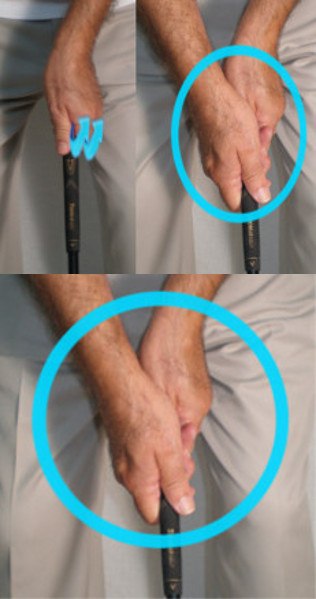
The Basics of Good Hand Placement
Before getting into how your hand placement can affect the type of ball flight you create with your swing, it is first important to understand some of the basics of good hand placement on the grip of the club. The small details your swing can go a long way toward helping you play good golf when you get them right. Learn how you should put your hands on the club and you will be a step ahead of your competition out on the course.
Following are three basic hand placement fundamentals that you should follow when hitting the majority of your shots.
- Palms face each other. Whether you use a 'strong' grip or a 'weak' grip, you need to make sure that the palms of your two hands are facing each other. This will allow the hands to work together nicely in the swing. If your hands are counteracting each other when you place them on the club, it will be difficult to get your arms to move correctly throughout the swing. If your left hand is going to be in a strong position on the grip, your right hand should be in a strong position as well. Likewise, a weak left hand grip needs to be matched by a weak right hand grip. As you are practicing taking your grip, always check to be sure that your palms are facing each other once the grip is complete.
- Use all of the grip. Unless you are hitting a modified shot of some kind (such as a punch shot), you want to be using the full length that the club has to offer. That means that your left hand should be placed all the way at the top of the grip and your right hand should be pushed up tightly to your left. When you choke down on the grip at address, you are shortening the length of the club – and reducing the swing speed that you can create through impact. This is a good approach to take when you want to reduce the distance of a particular shot – but for a standard shot where you want maximum distance, be sure to use all of the club.
- Light grip pressure. Remember as you are placing your hands on the club that you want to hit your shots with a light grip pressure throughout the swing. Squeezing the club is a common amateur mistake which can lead to a whole host of problems. It is harder to maintain good rhythm when you squeeze the grip tightly, and you will also struggle to release the club head fully through impact. If you are used to hitting shots with a tight grip, this is an adjustment that could take some time. Practice hitting your short shots with a light grip pressure first, and slowly work your way up to full swings.
If you can simply follow the three tips above for a standard grip, you will already be well on your way to proper hand placement. Your grip is the only place where you actually get to control the club, so it is imperative that you get this part of your technique correct.

A Strong Grip Favors a Draw
With the basic fundamentals out of the way, you can now turn your attention to how you can use hand placement to influence your ball flight. As mentioned above, using the correct grip to match up with your preferred ball flight will make success on the course much easier to achieve. You don't need to make drastic changes to your grip in order to see results, either – even making just a minor tweak in one direction or another can help to alter your ball flight in a positive manner.
To start, imagine that you are going to try using a draw as your primary ball flight. If that is the case, you are going to want to play with a strong grip. A strong grip is one that is turned to the right on the grip as you are looking down from address. For a reference point, try taking your grip and then looking down at your left hand to see how many knuckles are visible. If you can see at least three knuckles on the back of your left hand, you will know that you are using a strong grip.
The primary reason that a strong grip can lead to a draw ball flight is that your hands will be more active in the swing. When you turn your left hand to the right on the top of the grip – and then place your right hand to match – you will be putting a lot of control into your hands during the golf. For some players, this is a great way to play. For others, it will be less effective. Obviously, you are going to need to experiment with your own hand placement until you find a position that is comfortable and offers you the type of ball flight that you desire.
With your hands now more active in the swing thanks to a stronger grip position, you are going to need to be careful to make a full rotation through the shot on each and every swing. Having active hands through the hitting area will enable you to develop more club head speed – but it will also make it possible to hit a nasty hook if you fall behind with your lower body rotation. When the clubs moves through the ball prior to your body getting turned toward the target, the club face will likely close and the shot will hook quickly to the left. Players with a strong grip have to be specifically aware of this danger, and make a conscious effort to keep turning through the downswing in order to hit a draw rather than a hook.
Another warning for players who are going to use a strong grip – don't allow your hands to get too active in the takeaway. While it is nice to have the ability to use your hands aggressively through the ball on the downswing, using them too much in the takeaway is asking for trouble. If your hands have too much to do with the takeaway portion of the swing, the club will get stuck to the inside and you will again be in danger of hitting a hook. Try using your shoulders and torso to move the club in the takeaway while your hands remain passive. Only when the club head gets up off the ground by at least a few inches should you start to engage your hands in the backswing. If your draw starts to turn too much to the left during a round of golf, the first adjustment that you make should be to your takeaway. Keep your hands quiet and you should be able to repeat your draw over and over again without having the ball turn too hard to the left.
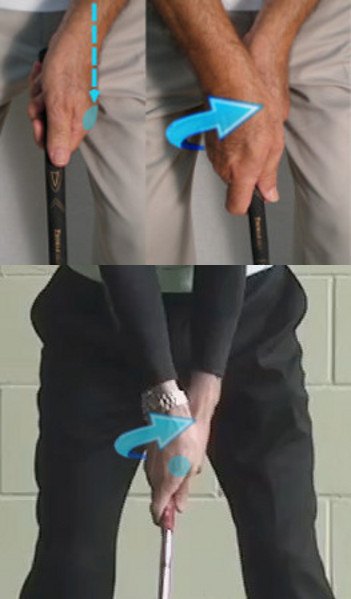
A Weak Grip Favors a Fade
It probably isn't a surprise at this point that a weaker grip will lend itself more comfortably to a fade. For everything that was explained in the previous section, the opposite can basically be stated in this section. A weak grip is one that is turned to the left on the grip. As you are looking down from address, you should only see two of the knuckles on the back of your left hand when you are using a weak hand position. If fact, some players use a grip that is so weak they are only able to see one knuckle – or even none. Try different weak left hand positions until you locate one that is comfortable to you. Once your left hand is comfortable on the club, you can then put your right hand in place to complete the grip.
The reason that you will have an easier time hitting a fade when you use a weak grip is simple – your hands will be less-engaged in the swing, so the club face won't rotate as much through the hitting area. It will be up to your body to rotate the club face back into a square position because your hands simply won't be able to manipulate the club head as much as they can with a strong grip. Again, this is a method that works great for some players and won't work at all for others. It is up to you to think about the type of swing that you make and decide if a weak grip will compliment your technique.
Players who tend to flourish while using a weak grip are those that make a big shoulder turn both in the backswing and in the downswing. Where a strong grip will allow you to use your hands and arms to move the club, a weak grip requires more of a 'body' swing to get the job done. If you lack the flexibility if your legs and back to make a big turn, you will probably be better off sticking with a strong grip. However, if you already make a big turn and have been using a strong grip, the switch to a weaker grip could quickly lead to improved consistency through a more-reliable ball flight.
One of the big benefits to a weak grip is simply not having to live in fear of the hook. Players with a strong grip are always capable of producing a sharp hook at the wrong time, even if most of their shots are well-controlled draws. All it takes is one lazy swing where the legs don't clear through the hitting area and a hook can result. You will have no such concerns when you use a weak grip. If you were to make a lazy swing with your weak grip, the ball will most likely float off line out of the right of your target. It still won't be a great shot, but it will almost always be a better result than you would get from a duck hook.
A common struggle that is experienced by players who switch to a weak hand position is the inability to hit shots solidly on the center of the club face. With a strong grip, your hands will be able to guide the club head into the back of the ball using basic hand-eye coordination. However, when you use a weak grip, you are limiting the role that your hand-eye coordination plays in the swing. Therefore it will be up to the mechanics of your body rotation to deliver the club accurately to the ball. This can certainly be done, but it might be a big change if you are used to using hand-eye coordination to find the sweet spot. In order to make a weak grip work in your game, your mechanics will need to be consistent from shot to shot.
When executed correctly, hitting fades using a weak grip is a beautiful way to play golf. Most players find that a fade is easier to control than a draw, and you will also enjoy the benefit of stopping the ball quicker when it lands on the green. With that said, it requires plenty of practice to fine-tune your body mechanics enough to execute this kind of swing round after round. If you decide that a fade is the right ball flight for you, make sure you are using a weak grip and then develop the rest of your swing mechanics to match.

Altering Hand Placement During a Round
As you have been reading the content above, you might have had a question pop into your head – 'Couldn't I just alter my grip based on the type of shot I wish to hit'? In other words, is it possible to change grips during a round depending on whether a draw or fade is the right shot for the job? Well, yes – it is possible. Is it a good idea? That is another question altogether.
It sounds like a great idea. You could go through each round simply adjusting your hand placement to either hit a draw or fade on command. Having that kind of control over the golf ball is a great advantage on any course. When you reach a dogleg right par four, you can simply adjust your grip weaker and hit a nice fade into the fairway. If the hole is turning to the left, you would go with your strong grip and hit the opposite shot. Of course, as you probably suspect, it doesn't really work that easily in the real world.
The problem is that your swing technique and mechanics are tied closely to the grip you use and the ball flight that you hit. If you were to go through your round while changing grips before each shot, your swing mechanics wouldn't be able to keep up. You might have a grip that is designed for a fade while the rest of your swing technique is engineered to hit a draw. Without having everything in your swing working in the same direction, the results are likely to be something less than ideal.
The bottom line is this – changing your hand placement on the club from shot to shot isn't a good idea. While you might occasionally hit a good shot using this approach, your consistently is likely going to suffer. Instead, you should work on learning how to turn the ball both directions by making other adjustments to your address position. By leaving your grip the same but changing your stance and ball position, you can successfully hit both draws and fades far more reliably.
To fade the golf ball, make the following adjustments –
- Open your stance by moving your left foot a few inches away from the ball at address
- Move the ball slightly forward in your stance
- Stand a couple of inches closer to the ball
These three minor changes to your pre-shot set up should be enough to encourage the ball to move from left to right in the air. To hit only a slight fade, you will want these changes to be rather subtle. If you want to hit a big fade, make the changes more dramatic.
On the other side of the equation, try the following adjustments to create a draw –
- Close your stance slightly by moving your right foot a few inches farther away from the ball
- Play the ball in the middle of your stance
- Stand a couple of inches farther away from the ball
Obviously, these adjustments are the opposite of what you will do when you try to fade the ball. Work on changing your stance following the guidelines above on the driving range to practice hitting draws and fades before you employ these techniques on the course.
The way you place your hands on the grip of the club has a direct impact on the ball flight that you will create with your swing. Experiment with different grip positions until you find one that perfectly complements your swing mechanics and leaves you with a ball flight that you can use effectively from the first hole to the last.






